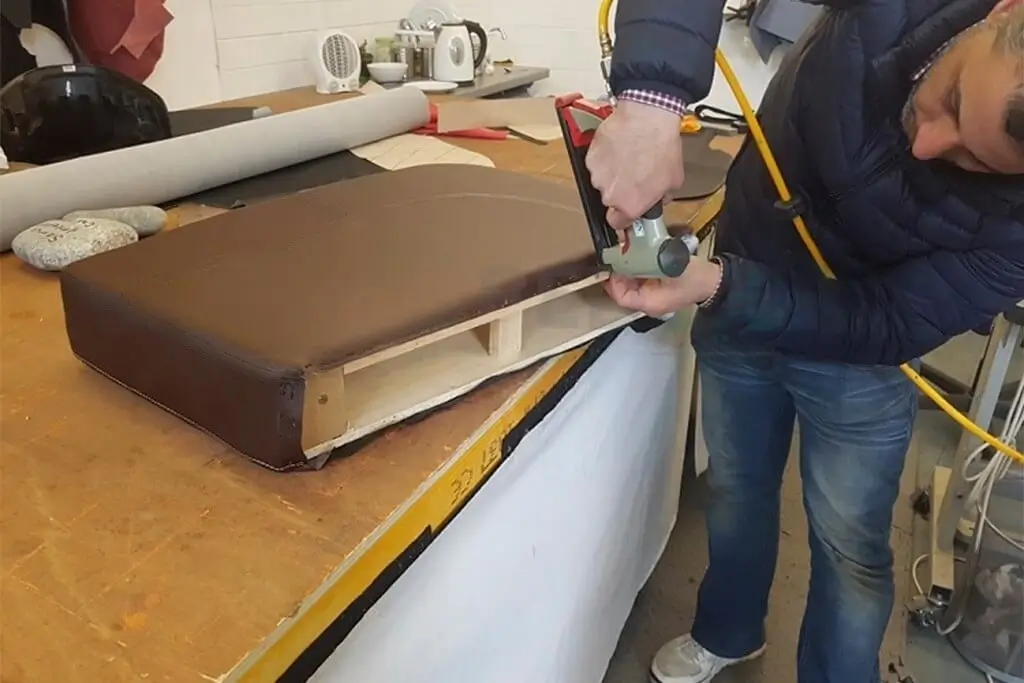Sofas are more than just pieces of furniture; they are the heart of our living spaces, where we gather, relax, and unwind. Over time, our beloved sofas may start showing signs of wear and tear – a loose seam here, a faded fabric there, or sagging cushions that are no longer as inviting as they once were. But before you consider replacing your sofa, consider the art of sofa repairing. With a bit of know-how and the right techniques, you can breathe new life into your cherished piece of furniture. Sofas are more than just pieces of furniture; they are the heart of our living spaces, where we gather, relax, and unwind. Over time, our beloved sofas may start showing signs of wear and tear – a loose seam here, a faded fabric there, or sagging cushions that are no longer as inviting as they once were. But before you consider replacing your sofa, consider the art of sofa repairing. With a bit of know-how and the right techniques, you can breathe new life into your cherished piece of furniture. In this blog post, we’ll explore the world of sofa repairing, offering tips and insights to help you restore your sofa to its former glory. In this blog post, we’ll explore the world of Sofa Repairing, offering tips and insights to help you restore your sofa to its former glory.
Assess the Damage before Sofa Repairing
Before embarking on a sofa repairing project, it’s essential to assess the extent of the damage. Identify the specific issues that need attention, whether it’s a torn fabric, a broken frame, or sagging cushions. This assessment will guide your repair process and help you determine the materials and tools you’ll need. Carefully inspect your sofa, taking note of any visible damage or areas that require attention. This step is crucial in developing a comprehensive plan for restoring your sofa to its original condition.
Gather Your Tools and Materials for Sofa Repairing
Once you’ve identified the issues, gather the necessary tools and materials for the job. Common tools and supplies for sofa repairing may include:
- Sewing kit: For repairing seams and tears in upholstery.
- Fabric swatches: To match or replace damaged upholstery.
- Upholstery foam: For rejuvenating sagging cushions.
- Staple gun: Useful for securing fabric and springs.
- Screws and screwdriver: For fixing loose or broken frames.
- Wood glue: To bond and reinforce wooden parts.
- Needle-nose pliers: Handy for removing staples and tacks.
- Upholstery adhesive: For securing fabric in hard-to-reach places.
- Safety gear: Always wear safety glasses and gloves when working with tools.
Having these tools and materials at your disposal ensures that you’re well-prepared to tackle the specific repairs your sofa needs. It’s essential to have everything organized and within reach before you begin, as this will streamline the repair process and help you achieve the best results.
Sofa Repairing Common Issues
Sofas can experience a range of common issues over time, from torn upholstery to sagging cushions and even frame damage. Here’s a guide on how to address these issues and bring your sofa back to life:
- Reupholstering:
- If your sofa’s upholstery is worn or torn, reupholstering can make a significant difference.
- Carefully remove the old fabric, taking care not to damage the padding or frame underneath.
- Cut and attach the new fabric, ensuring it’s taut and wrinkle-free.
- Secure the fabric with staples or upholstery adhesive, and trim any excess fabric for a clean finish.
- Fixing Sagging Cushions:
- Sagging cushions can be uncomfortable and affect the overall look of your sofa.
- Begin by removing the cushion covers.
- Insert new upholstery foam or batting to plump up the cushions and restore their shape.
- Reattach the cushion covers, ensuring they fit snugly.
- Frame Repairs:
- If your sofa’s frame is damaged or weakened, it’s crucial to address this issue for structural integrity.
- Remove any loose or broken parts of the frame.
- Apply wood glue to the damaged areas, ensuring a solid bond.
- Clamp the parts together and allow them to dry thoroughly.
- To reinforce the repair, consider adding screws for extra stability.
By addressing these common sofa issues, you can extend the life of your beloved piece of furniture and enjoy its comfort and functionality for years to come. Whether it’s a tear in the fabric, sagging cushions, or frame damage, with the right tools and materials, you can successfully repair your sofa and preserve its place in your home.
Seek Professional Help When Needed
While many sofa repairing can be tackled as DIY projects, some complex issues may require the expertise of a professional upholsterer or furniture repair specialist. It’s essential to recognize when a repair job exceeds your skills and tools. Here are some situations where seeking professional help is advisable:
- Structural Damage: If your sofa has significant structural damage, such as a broken frame or damaged springs, it’s best to consult a professional. Structural repairs are critical for safety and the longevity of your sofa.
- Antique or Valuable Pieces: If you own an antique or valuable sofa, attempting repairs on your own can risk devaluing the piece. Professionals have the experience to handle delicate and valuable furniture with care.
- Complex Upholstery: Reupholstering can be a complex task, especially for sofas with intricate designs or unique fabrics. Professionals have the skills and equipment needed to achieve high-quality results.
- Time Constraints: If you lack the time or patience for a repair project, hiring a professional ensures a quicker turnaround and a well-executed job.
- Lack of Expertise: If you’re unsure about the specific repair techniques or lack the necessary tools, professionals can provide the expertise needed to ensure a successful repair.
When in doubt, consult with a reputable furniture repair service or upholsterer. They can assess the extent of the damage and provide guidance on the best course of action. While DIY repairs can be rewarding, knowing when to seek professional help ensures that your sofa is restored to its best possible condition.
Regular Maintenance and Care of Sofa Repairing
Taking proactive steps to maintain and care for your sofa can significantly extend its lifespan and keep it looking its best. Here are some essential tips for regular sofa maintenance and care:
- Regular Cleaning: Dust and debris can accumulate on your sofa’s surface, affecting its appearance. Use a vacuum cleaner with an upholstery attachment to remove loose dirt and dust regularly. Be sure to get into crevices and under cushions.
- Rotate and Flip Cushions: To ensure even wear and maintain the shape of your sofa cushions, rotate and flip them regularly. This helps prevent certain areas from becoming more worn or flattened than others.
- Use Armrest Covers: If your sofa’s armrests are susceptible to stains or wear, consider using armrest covers. These protective covers can be removed and washed, helping to keep your sofa looking clean and fresh.
- Avoid Direct Sunlight: Prolonged exposure to direct sunlight can cause upholstery fabric to fade over time. Position your sofa away from direct sunlight or use curtains and blinds to block UV rays.
- Regular Fluffing: If your sofa has loose back cushions, fluff them regularly to maintain their shape and provide optimal comfort. Gently pat and shake the cushions to redistribute the filling.
- Address Spills Promptly: Accidents happen, so it’s essential to address spills and stains promptly. Blot the affected area with a clean, dry cloth to absorb the liquid, then follow up with a fabric-friendly stain remover or upholstery cleaner according to the manufacturer’s instructions.
- Protect Pets: If you have pets, consider using sofa covers or throws to protect your sofa from pet hair, scratches, and accidents. Regularly vacuum pet hair and use lint rollers to keep your sofa clean.
- Professional Cleaning: Every few years, or as needed, consider having your sofa professionally cleaned by upholstery cleaning experts. They can deep clean and refresh your sofa, removing deep-seated dirt and odors.
- Check for Loose Fasteners: Periodically inspect your sofa’s legs, screws, and fasteners. Tighten any loose components to ensure stability and safety.
- Follow Manufacturer’s Guidelines: Always follow the care and maintenance instructions provided by the manufacturer. Different fabrics and materials may require specific care procedures.
By incorporating these regular maintenance and care practices into your sofa care routine, you can ensure that your sofa not only looks its best but also remains comfortable and functional for years to come. With proper care, your sofa can continue to be a welcoming and cozy centerpiece in your home.
Conclusion
The art of sofa repairing is a skill that can breathe new life into your cherished furniture and extend its longevity. Before you consider parting with your beloved sofa due to wear and tear, explore the possibilities of repairing and restoring it. Through careful assessment, gathering the right tools and materials, and addressing common issues like reupholstering, fixing sagging cushions, and frame repairs, you can transform your sofa into a functional and aesthetically pleasing piece once again.
However, it’s crucial to recognize when professional help is needed, especially for complex structural repairs or valuable antique pieces. Seeking expert assistance ensures that your sofa is handled with the care and expertise required for a successful restoration.
Regular maintenance and care are equally essential to keep your sofa looking and feeling its best. Simple practices like regular cleaning, cushion rotation, and stain prevention can significantly prolong your sofa’s life, ensuring it remains a comfortable and inviting centerpiece in your home.
In conclusion, the art of sofa repairing is a practical and eco-friendly approach to preserving your furniture and the memories associated with it. By embracing the principles of assessment, repair, and maintenance, you can continue to enjoy the comfort and beauty of your sofa for many years to come, making it a valued and timeless part of your home.



